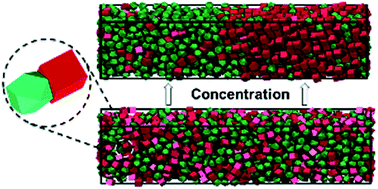Phase behavior of binary mixtures of hard convex polyhedra
Abstract
Shape anisotropy of colloidal nanoparticles has emerged as an important design variable for engineering assemblies with targeted structures and properties. In particular, a number of polyhedral nanoparticles have been shown to exhibit a rich phase behavior [Agarwal et al., Nat. Mater., 2011, 10, 230]. Since real synthesized particles have polydispersity not only in size but also in shape, we explore here the phase behavior of binary mixtures of hard convex polyhedra having similar sizes but different shapes. Choosing representative particle shapes from those readily synthesizable, we study in particular four mixtures: (i) cubes and spheres (with spheres providing a non-polyhedral reference case), (ii) cubes and truncated octahedra, (iii) cubes and cuboctahedra, and (iv) cuboctahedra and truncated octahedra. The phase behavior of such mixtures is dependent on the interplay of mixing and packing entropy, which can give rise to miscible or phase-separated states. The extent of mixing of two such particle types is expected to depend on the degree of shape similarity, relative sizes, composition, and compatibility of the crystal structures formed by the pure components. While expectedly the binary systems studied exhibit phase separation at high pressures due to the incompatible pure-component crystal structures, our study shows that the essential qualitative trends in miscibility and phase separation can be correlated with properties of the pure components, such as the relative values of the order–disorder transition pressure (ODP) of each component. Specifically, if for a mixture A + B we have ODPB < ODPA and ΔODP = ODPA − ODPB, then for any particular pressure at which phase separation occurs, the larger the ΔODP the lower the solubility of A in the B-rich ordered phase and the higher the solubility of B in the A-rich ordered phase.


 Please wait while we load your content...
Please wait while we load your content...